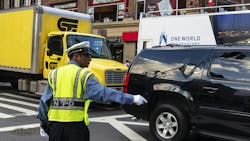New York City’s congestion fees plan finds more trucking pushback
The threat of new fees to reduce traffic challenges in New York City has been sending shockwaves across the transportation industry recently.
A new congestion fee was set to be implemented on June 30 for all vehicles, including truckers who frequently transport freight in and out of Manhattan. However, it’s now been indefinitely delayed by New York Governor Kathy Hochul due to concerns about timing and New York State’s post-pandemic recovery as the city struggles with crime affecting public transportation. Revised congestion pricing alternatives are still being hotly debated, including other options such as raising the payroll tax paid by local businesses, yet implementing the now delayed congestion fee is still on the table.
The Metropolitan Transportation Authority is the group behind the new proposed congestion toll. It’s a plan that’s been in the works for several years, designed to alleviate bumper-to-bumper traffic, improve air quality, and serve as a revenue source to fund an upgrade of the city’s aging public transportation system.
See also: How traffic congestion stifles urban growth and quality of life
Under the initial pricing plan, vehicles entering Manhattan south of 60th Street (renamed the Congestion Relief Zone) were set to be charged $15 or more to drive through the area starting in late June. Trucks and buses would be hit with fees ranging from $24-$36, depending on vehicle size and the time of day.
Opposition from truckers, business owners, and more
As the congestion fees loomed, several transportation companies, small-business owners, unions, government officials, and others boldly spoke up and took action to delay or stop the controversial pricing plan.
In late May, the Trucking Association of New York, a trade group representing delivery companies, filed a lawsuit, claiming that the steep fees would ultimately hurt small and midsize businesses and their customers. At least five to seven other entities were in the process of taking additional legal action against the city’s congestion plan.
Local businesses were already feeling the pinch as the proposed pricing plan left businesses wondering how to navigate the new fees while remaining profitable. A Brooklyn-based HVAC service company had already started alerting its customers in the Congestion Relief Zone that they would see a $15 surcharge for all work orders to compensate for the new fees. Other companies in the zone suggested slashed hours, staff reductions, and layoffs to offset the fees and expected decrease in customers and sales. New Yorkers were also grappling with how they would traverse their home turf. A consumer poll conducted by Siena College in April 2024 found that 63% of residents opposed the MTA’s congestion pricing plan, with 17% revealing they’d find other ways to travel around Manhattan.
A domino effect for all involved
Experts say a “domino effect” may occur if this plan or a similar one is enacted in the future, driving up prices that New Yorkers pay for basic goods and services—an unwelcome price hike in one of the world’s most expensive cities. If the plan moves forward at some point, many trucking companies will likely raise their delivery rates, forcing local businesses to increase product prices in response—eventually hitting consumers’ wallets.
Businesses that offer or use perishable goods and services, such as florists, restaurants, hospitals, grocers, pharmacies, and others, would be hardest hit by the “domino effect” and may possibly see a disruption in vendor delivery service.
See also: How optimizing routes can impact truck driver satisfaction
The trucking industry is a low-margin business. Most fleets, especially smaller ones, are not in the financial position to absorb add-on fees and taxes. According to 2023 research, the top industry challenge for smaller fleets is operational costs, such as fuel prices, insurance premiums, maintenance costs, declining shipping rates, and increased competition. Adding the MTA’s congestion toll adds to the challenges many fleets already face in staying afloat.
Mapping and routing solutions
For many in the trucking industry, freight deliveries to Manhattan’s Congestion Relief Zone might be inevitable, underscoring how critical reliable mapping intelligence tools are. Powered by real-time data and mapping technology, truckers and commercial vehicles rely on these tools to navigate heavy traffic, unexpected delays, or weather issues and better optimize their routes using dynamic and proven industry applications.
In New York City, ranked one of the most congested traffic cities in the world by the TomTom Traffic Index, finding route efficiencies can be extremely difficult. The typical New York driver spent an average of 23 minutes and 58 seconds to commute just six miles last year. During peak times, drivers in New York City travel at an average speed of 12 mph. In Manhattan, it’s even slower; traffic crawls at an average speed of only 7 mph.
While New York City poses unique traffic challenges, innovative tools and strategies get truckers where they need to be. A robust transportation management system with user-friendly applications for routing, mapping, scheduling, and safety measures better equips fleets of all sizes to meet unexpected business challenges—big or small—such as congestion fee tolls in New York City and beyond.
About the Author

Rishi Mehra
VP of Commercial Mapping and Routing Technology
Rishi Mehra is vice president of commercial mapping and routing technology for Trimble. He has more than 25 years of experience in the transportation and mapping industry, with experience executing new business models, designing framework for long-term strategic partnerships, and leading cross-functional teams across engineering, sales, and operations.
